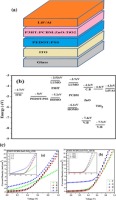
Quaternary blend hybrid organic solar cells enjoy both an increased light absorption range and an easy method to fabricate because of the simple structure. In this study effects of mixing inorganic metal oxides (ZnO and TiO2) nanoparticles to the active layer of organic photovoltaics devices were investigated. The active layer primarily consists of various ratios of electron donor poly (3-hexylthiophene) (P3HT) and an electron acceptor [6,6]-phenyl-C61-butyric acid methyl ester (PCBM) together with nanostructured ZnO and TiO2dispersed in chlorobenzene (CB) and 1,2-dichlorobenzene (DCB). The ratio of PCBM to nanoparticles was varied keeping the ratio of P3HT to acceptor material constant. Mixing of nanoparticle plays a significant role in the resulting power conversion efficiency (PCE) of the devices. An increased PCE for ZnO/TiO2 doped devices can be attributed to increased absorption in the visible region and enhanced charge collection due to the percolation networks formed by metal oxides nanoparticles. Materials Research Bulletin, 2015 |

